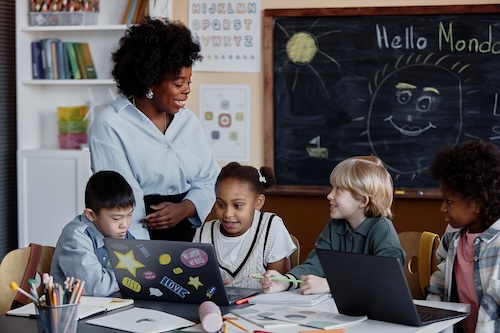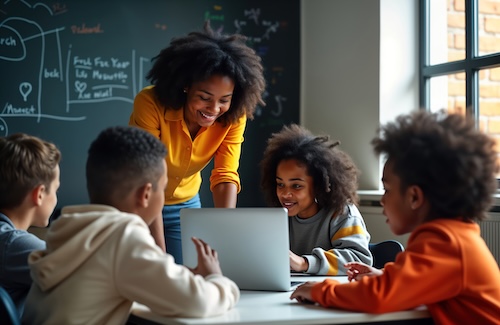Key points:
Technology in the classroom has transformed how students learn and how teachers teach. What once was a space filled with lectures, textbooks, and rigid routines has evolved into a dynamic, interactive environment fueled by digital learning tools and creative teaching strategies.
In today’s schools, the thoughtful integration of educational technology isn’t a luxury–it’s a necessity to support the diverse learning styles and needs of every student.
Teaching for today’s students
Traditional teaching models–centered on passive learning–are becoming increasingly obsolete. Students no longer thrive in classrooms that demand silence and memorization. They crave engagement, relevance, and personalization. Technology in the classroom helps meet these demands by supporting auditory, visual, kinesthetic, and tactile learners through varied digital learning tools and multimedia content.
Harvard psychologist Howard Gardner’s theory of multiple intelligences remains influential, reminding us that students bring a wide range of strengths into the classroom. Educational technology offers the means to tap into those intelligences through virtual labs, educational games, graphic design platforms, interactive timelines, and storytelling tools. Whether it’s a podcast for an auditory learner or an infographic project for a visual student, tech-rich instruction makes differentiation more attainable–and more effective.
Blending teaching methods with digital tools
Modern instruction is all about variety. Teachers now design lessons that blend direct instruction with digital collaboration. Instead of being limited to chalkboards and worksheets, they can use platforms like Google Workspace for Education, Flip, or Kahoot! to engage learners in meaningful ways.
Visual learners benefit from digital whiteboards, drawing tools, and concept maps that allow them to make sense of abstract ideas. Kinesthetic learners thrive in gamified settings or hands-on simulations, whether it’s a math puzzle on Prodigy or a virtual science experiment using Labster.
And for tactile learners, touchscreen devices and drag-and-drop exercises allow them to engage with content in a physical, intuitive way.
Most importantly, students become creators–not just consumers–of content. They produce videos, record their own voiceovers, and design digital posters to demonstrate understanding.
When technology in the classroom is student-driven, learning becomes more active and authentic.
Keeping up with changing technology
Today’s learners are digital natives. According to a 2022 Common Sense Media report, more than 90 percent of U.S. teens have access to a smartphone, and nearly as many report using digital learning tools for schoolwork. But there’s often a disconnect between how students use technology at home versus at school. While they might use apps like Canva, ChatGPT, or YouTube to learn independently, some schools still limit students to static platforms or outdated tools.
Bridging this gap requires intentional, ongoing teacher development. Educators need support in learning how to use and evaluate technology–not just for classroom management, but for student engagement strategies that drive deeper learning. ISTE offers frameworks, such as the ISTE Standards for Educators, which guide teachers in designing and delivering 21st-century teaching methods.
Professional learning communities (PLCs), tech coaching, and district-wide integration plans are essential for sustaining the use of educational technology. It’s not about having the latest gadget–it’s about knowing how to use the tools already available to enhance student learning.
Equity and the digital use divide
One of the greatest challenges in modern education is ensuring equitable access to technology. While many schools now provide 1:1 device programs, disparities remain in how technology is used. The OECD describes a “digital use divide” where some students engage in meaningful, creative learning with technology, while others only use it for repetitive, low-level tasks.
Technology in the classroom must be more than just screen time. It must be purposeful. When students are taught to research critically, collaborate online, and create digital projects, they develop real-world skills that prepare them for the future. But this transformation must happen for every learner, not just those in well-funded districts.
School leaders must ensure all students have access to robust digital learning tools, high-speed internet, and teachers who know how to integrate those tools effectively. Without these supports, 21st-century teaching methods can fall flat or widen equity gaps.
Looking ahead
The pandemic made clear that flexibility, creativity, and digital literacy are essential components of modern instruction. As we continue to reimagine what learning looks like, educational technology should serve as both the vehicle and the compass–driving student engagement strategies while guiding students toward deeper understanding.
The challenge now is to ensure that all students benefit from the promise of technology in the classroom. That means listening to their needs, investing in teacher training, and integrating tools that foster collaboration, creation, and critical thinking.
Conclusion
Technology in the classroom empowers teachers to teach more effectively and students to learn more meaningfully. When used intentionally, it helps bridge learning gaps, address diverse learning styles, and prepare students for a digital future. The key is not the technology itself, but how we use it–to inspire curiosity, encourage creativity, and spark a lifelong love of learning.





